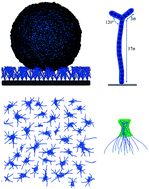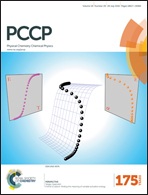Understanding the wettability of a hairy surface: effect of hair rigidity and topology†
Abstract
We present a computer simulation study on the wettability of a hairy surface with different topological structures such as single hairs, hair bundles and network structure. Superficially, for end-tethered rigid hairs or flexible hairs, the nonwettability of the substrate should be analyzed in completely different ways. For rigid hairs, the contact angle is dominantly dependent on the top layer density of hairs. A larger top layer density leads to a larger interaction between droplet and surface, as well as a lower contact angle. For flexible hairs, the nonwettability is determined by the typical properties of hairs right below the droplet, e.g., the chemistry of the surface, the topography and strength of the hair bundle/network or nonwetted area below the projection of the droplet. Nevertheless, it is also possible to generalize these aspects into a uniform procedure, which implies an intrinsic consistent mechanism of the dewetting behavior for droplets on such hairy surfaces. Counterintuitively, we also suggest that the surface which can strongly resist the transition to the Wenzel state does not necessarily lead to a large contact angle, especially in a system where the droplet is treated as liquid bulk. This study helps to build up guidelines for the design of nonwetting surface materials.


 Please wait while we load your content...
Please wait while we load your content...